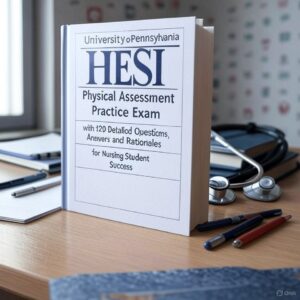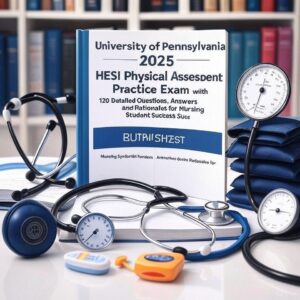-
Includes 120 detailed practice questions with answers and rationales.
-
Covers essential topics: physical examination, vital signs, and clinical assessment techniques.
-
Offers in-depth explanations to enhance understanding and retention.
-
Features realistic scenarios to connect theory with practical application.
-
Aligned with University of Pennsylvania’s nursing curriculum standards.
-
Supports HESI and NCLEX-RN preparation with targeted remediation tools.
-
Provides insights into the 2025 HESI Physical Assessment Exam format.
Preview
On inspection of a patient’s hands, the nurse notices ulnar deviation and swan-neck
deformities bilaterally and correlates this finding with which disorder?
a. Osteoarthritis
b. Osteoporosis
c. Rheumatoid arthritis
d. Gout – – correct ans- -Ans C
A The findings are consistent with rheumatoid arthritis.
B The findings are consistent with rheumatoid arthritis.
C Ulnar deviation, swan-neck, and boutonnière deformities of interphalangeal joints are
manifestations of rheumatoid arthritis.
D The findings are consistent with rheumatoid arthritis.
With the patient lying supine, a nurse raises the patient’s leg to flex the hip. The patient
complains of pain when the leg is raised to 40 degrees. The nurse correlates this finding
with which disorder?
a. Lumbar nerve compression
b. Cervical disk herniation
c. Osteoarthritis
d. Bursitis – – correct ans- -Ans A
A To evaluate for nerve root irritation or lumbar disk herniation, perform straight leg
raises. Pain in the back of the leg with 30 to 60 degrees of elevation indicates pressure
on a lumbar peripheral nerve by an intervertebral disk.
B Straight leg raises evaluate for herniated disks, but not in the cervical disks in the
neck.
C Osteoarthritis is a degenerative disease of articular cartilage that affects weight
bearing joints such as vertebrae, hips, knees, and ankles. Straight leg raises is not a
technique to assess for osteoarthritis.
D Bursa become inflamed by constant friction around joints and may be precipitated by
arthritis or injury. The hip is a common site, but not vertebrae. Manifestations include
painful range of motion, point tenderness, and erythema of the affected joint.












Reviews
There are no reviews yet.